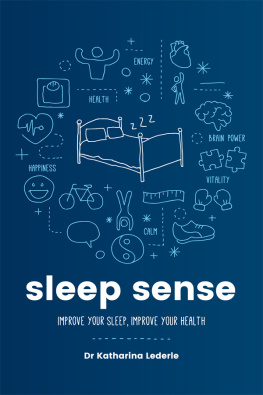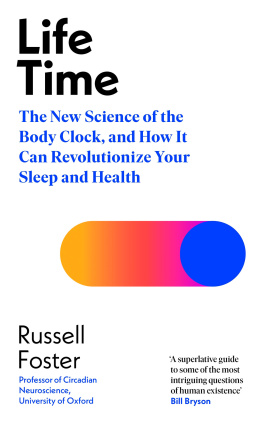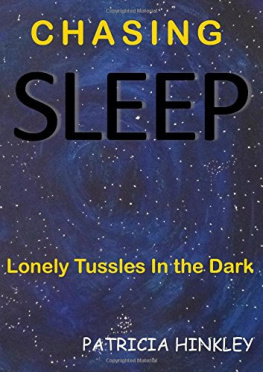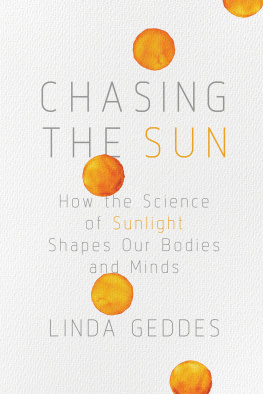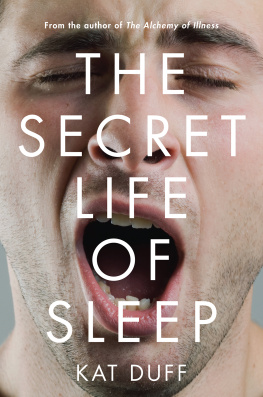
WELLCOME COLLECTION is a free museum and library that aims to challenge how we think and feel about health. Inspired by the medical objects and curiosities collected by Henry Wellcome, it connects science, medicine, life and art. Wellcome Collection exhibitions, events and books explore a diverse range of subjects, including consciousness, forensic medicine, emotions, sexology, identity and death.
Wellcome Collection is part of Wellcome, a global charitable foundation that exists to improve health for everyone by helping great ideas to thrive, funding over 14,000 researchers and projects in more than seventy countries.
wellcomecollection.org
Chasing the Sun
ALSO BY LINDA GEDDES
Bumpology: The myth-busting pregnancy book for curious parents-to-be
Linda Geddes
Chasing the Sun
The new science of sunlight and how it shapes our bodies and minds

Published in association with Wellcome Collection
First published in Great Britain in 2019 by
Profile Books Ltd
3 Holford Yard
Bevin Way
London
WC1X 9HD
www.profilebooks.com

183 Euston Road
London NW1 2BE
www.wellcomecollection.org
Copyright Linda Geddes, 2019
Cover image istock
The moral right of the author has been asserted.
All rights reserved. Without limiting the rights under copyright reserved above, no part of this publication may be reproduced, stored or introduced into a retrieval system, or transmitted, in any form or by any means (electronic, mechanical, photocopying, recording or otherwise), without the prior written permission of both the copyright owner and the publisher of this book.
A CIP catalogue record for this book is available from the British Library.
ISBN 9781781258323
eISBN 9781782833499
For my mum, who tracks the lengthening evenings with brightening spirits
Introduction
IF EVER YOU NEED a reminder of the suns awesome power, the Mojave Desert is a good place to start. In summer, when the daytime temperature frequently hits 49C (120F), stepping outside feels like opening the door to a giant furnace.
The local flora and fauna arm themselves against this heat: Joshua trees grow tough, concave spikes for leaves, minimising water loss and channelling what little rain does fall down towards their trunk and roots; jackrabbits develop enormous ears with shallow blood vessels that allow their body heat to quickly evaporate. Other creatures are nocturnal or emerge only at dawn or dusk to avoid the suns heat; while yet others, such as the desert tortoise, sleep out the entire summer in underground burrows. Then there are vultures, which cool off by peeing onto their own legs.
Humans are less well equipped for such harsh conditions. In the Sonora Desert immediately to the south, hundreds of Central American migrants meet their deaths each year while trying to cross the border into the USA, the sun stripping away their body fluids and causing them to overheat.
Yet the suns power also creates opportunities. Plants harness its rays to generate food, while shimmering solar farms are springing up, bent on transforming those rays into electricity. At the largest of these the Ivanpah Solar Plant, 45 miles south-west of Las Vegas a glittering sea of sun-tracking mirrors captures and focuses sunlight onto three boiler-topped towers, which drive turbines that supply electricity to hundreds of thousands of homes. Pity any bird crossing the path of these concentrated sunbeams, though: theyre known as streamers, referencing the wisps of white smoke left in their wake as they are instantly incinerated. Across the ages, in civilisations separated by thousands of miles of land or ocean, people have revered the sun as both a creator and a destroyer a relationship that continues to this day.
In Las Vegas, though, which rises out of this hostile landscape in defiance, the sun has been dethroned. At night, the neon-soaked Strip is reportedly the brightest place on earth, while the strongest artificial light on the planet emits from the tip of the Luxor Resort and Casinos glass and steel pyramid: each night, it sends this powerful sky beam upwards, as if issuing a direct challenge to our nearest star. On a clear night, airline passengers can see the beam from some 275 miles away, and their pilots use it to help them navigate. The artificial light also confuses the navigation systems of insects, luring them to their deaths: the concentrated swarms provide a buffet for bats, which are in turn feasted upon by swooping owls.
Elsewhere in Vegas, realising the power it wields over our minds and spirits, resort owners have deliberately banished the sun from their casino floors. The 24-hour cycle of light and darkness is crucial to our internal sense of time; if there are no windows, its easier for gamblers to lose track of it and stay for hours longer than they mean to particularly if artificial light is deployed to wake them up. Some casinos even go so far as forbidding dealers from wearing a watch, so that if anyone asks the time, they cant say. Chairs are ergonomically designed to allow players to sit for hours in comfort, while oxygen is pumped in to boost alertness.
In this twilit world, artificial light reigns supreme, and it can have a huge effect on us: strategically placed spotlights draw consumers towards jangling, flashing slot machines; but the colour of the lighting can also be deliberately tweaked to manipulate peoples behaviour. Blue-white light simulates daylight and makes people feel more alert, which can fool them into lingering longer at tables and slot machines. Meanwhile, red light can raise our level of physiological arousal: a study has shown that people gamble more money, place more bets and choose riskier options under red light, compared to blue. Pair that red light with fast music, another study showed, and people will bet faster on roulette.
Some time ago, I found myself in the middle of this muddled-up world, while covering a conference for New Scientist magazine. Giddy with jet lag and having spent the entire day in a windowless meeting room, I was desperate to spend the few spare hours I had soaking up some sunlight. It was October which meant that the suns ferocious heat was muted somewhat and the desert sky was cloudless, yet the entire city seemed set up to hide this fact, with chains of underground malls linking one hotel to the next so that you never have to step outside.
Finally, I found myself surrounded by mock-Greco-Roman architecture in the labyrinthine mall of Caesars Palace, glimpsing what appeared to be daylight up ahead. My excitement was quickly deflated as I drew closer and looked up: above me soared an impressive yet completely artificial sky. As I slumped, defeated, next to a replica of Romes Trevi Fountain, it struck me just how perverted our relationship with natural light has become.
* * *
Our biology is set up to work in partnership with the sun. Life itself arose on earth because its relationship with the sun was a special one. Earths distance from the sun, not too close and not too far away, meant that the water on its surface remained liquid, whereas on Venus it was baked away, and on Mars it was locked up as ice. Sunlight-driven reactions may also have provided the molecular raw materials necessary for the evolution of life in these early oceans. Some 1.4 billion years later, tiny single-celled organisms called cyanobacteria had evolved, which clumped together, forming brilliant blue-green rafts. And though they were individually tiny, they achieved extraordinary feats: taking the suns light and turning it into chemical energy through photosynthesis, which they stored away as sugar, thus incorporating sunlight into their very being. In the process, they produced oxygen, which accumulated and transformed earths atmosphere into the hospitable place we know today.
Next page



